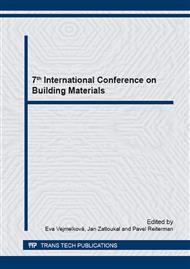p.1
p.7
p.13
p.21
p.27
p.33
p.39
p.43
Latent Heat Storage in Plasters with Incorporated PCM Water Dispersion
Abstract:
The sustainability principles in building sector promote a development of new building materials and products directly designated for improvement of the thermal performance of buildings related to the energy saving for the interior climate conditioning. In order to comply with this concept and improve the thermal comfort of buildings environment, incorporation of phase change materials (PCMs) into the construction elements giving ability to store and release heat looks like a beneficial material solution. On this account, the mechanical, rheological and thermal properties of cement-lime dry plaster mixture with addition of 4, 8 and 12 mass% of PCM water dispersion are experimentally investigated in the paper. The increasing amount of applied PCM admixture causes the significant improvement of the plaster heat storage capacity in dependence on temperature exposure applied in the performed DSC experiment. Contrary to this positive finding, the higher content of tested polymer microencapsulated PCM in plaster matrix leads to the lower mechanical strength. However, it is still sufficient for construction applications.
Info:
Periodical:
Pages:
1-6
Citation:
Online since:
July 2015
Authors:
Price:
Сopyright:
© 2015 Trans Tech Publications Ltd. All Rights Reserved
Share:
Citation:


